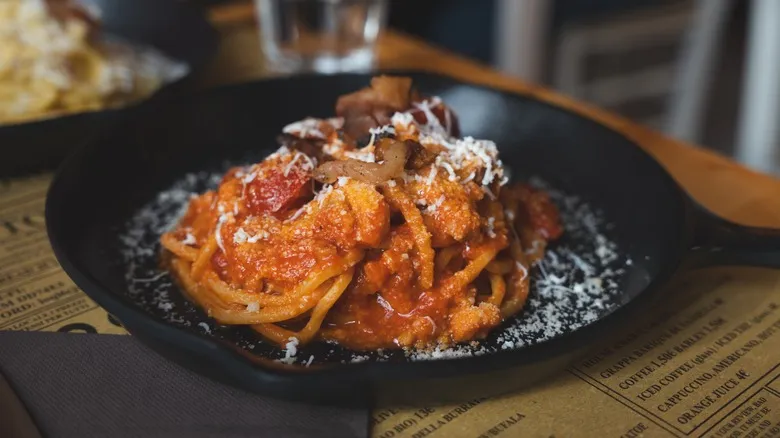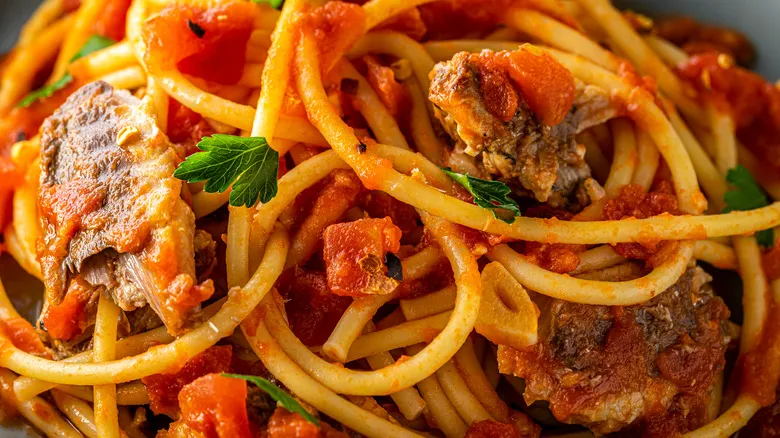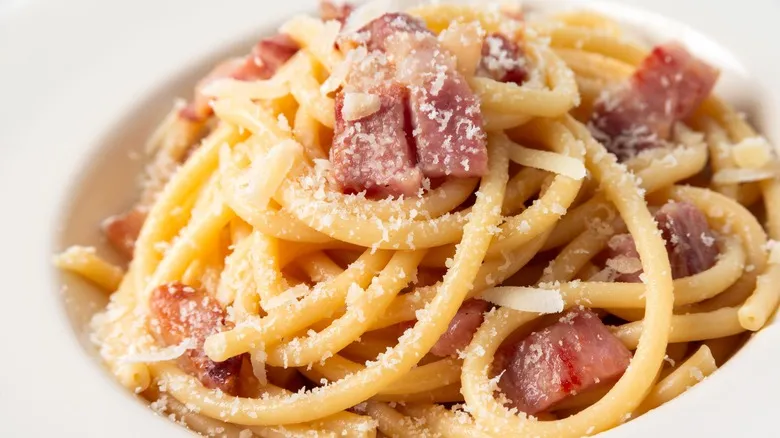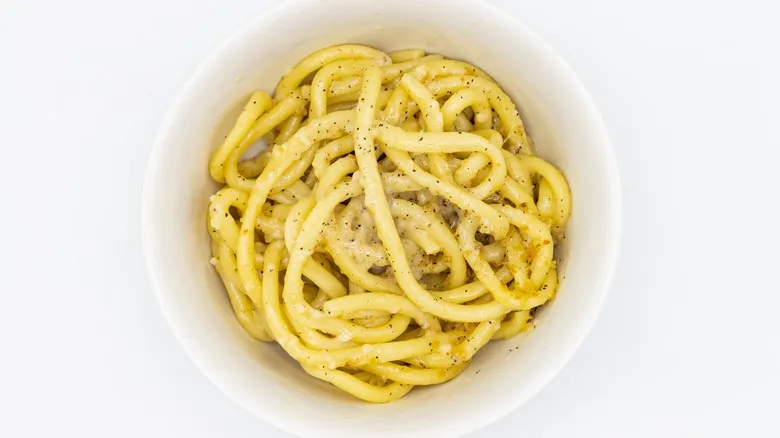Amatriciana is the classic match for bucatini

Bucatini is most commonly linked to the classic dish bucatini all'Amatriciana. Chef Mirabile describes this as his favorite sauce, filled with nostalgia. "As a child, it was always a special occasion when my father prepared this on a Sunday," he reminisces. Alongside cacio e pepe, pasta alla gricia, and carbonara, Amatriciana is one of the four foundational pastas of Rome, although it is believed to be named after the town of Amatrice, located about 90 miles to the east. Traditionally served with spaghetti, it has now become most closely associated with bucatini. As Chef Mirabile notes, "This pasta shape is excellent for holding the sauce due to its distinctive design."
Amatriciana, like the other three Roman pastas, exemplifies the beauty of simplicity. The sauce begins with frying diced guanciale, a type of cured pork jowl similar to pancetta. The other essential ingredients are tomatoes and red chili flakes. Some variations include onions, though this is not the traditional approach. A generous sprinkle of Rome's cherished Pecorino Romano cheese is crucial to unify the dish. It's hearty and comforting, allowing each ingredient to shine. However, while it is delicious, it is far from the only way to enjoy bucatini.
Bucatini con le sarde is an underrated holiday classic

While Chef Mirabile may declare Amatriciana as his favorite sauce, he also harbors a strong affection for another, less familiar bucatini dish. "As someone of Sicilian heritage, I eagerly anticipate St. Joseph's Day on March 19, when my family prepares this pasta for the renowned Sarde sugu." This dish, often referred to as pasta con le sarde, is closely tied to the celebration. St. Joseph's Day occurs during Lent, a season when the consumption of meat is traditionally restricted. Instead, fish is preferred, and this dish derives its name from the use of sardines.
There are several variations of pasta con le sarde, but Chef Mirabile particularly recommends, "Milanese pasta made with sardines, tomatoes, and fennel." Pasta Milanese is another popular name for this classic St. Joseph's Day dish, which can also be prepared with a similar fish: anchovies. To complete the meal, generously top it with toasted breadcrumbs, which hold special meaning for the feast. These crumbs represent sawdust, paying homage to Joseph's trade as a carpenter.
You can't go wrong with carbonara

A prevalent motif associated with bucatini is its strong link to Roman cuisine. This pasta shape hails from Lazio, the Italian region that encompasses Rome and the nearby Amatrice. Therefore, it’s only natural that bucatini features prominently in one of Rome's most iconic pasta dishes: carbonara. While spaghetti is the traditional choice for this dish, many Roman eateries opt for bucatini instead. "When in Rome," Chef Mirabile remarks, "I truly appreciate it when a restaurant serves bucatini with authentic Roman carbonara."
So, what constitutes "authentic" Roman carbonara? According to Chef Mirabile, it should consist of just three ingredients: "eggs, Romano cheese, and guanciale." Similar to Amatriciana, the initial step involves frying the guanciale to render its rich fat, which is essential for the sauce's beloved savory taste. When cooking the bucatini, combine it with the guanciale in the pan, and remove the pan from the heat before adding the eggs. The residual warmth from the pasta and guanciale will transform the eggs into a creamy, silky sauce, enhanced by a generous sprinkle of pecorino romano. A hearty dash of freshly cracked black pepper is also a traditional touch.
Cacio e pepe is the simplest sauce for bucatini

Bucatini may not be the most recognized pasta among many, but its popularity has been rapidly increasing, especially in relation to one of the world's most beloved pasta dishes. "In recent years," says Chef Mirabile, "this pasta shape has gained significant traction with Cacio e Pepe, a straightforward sauce made from Romano cheese and black pepper." Indeed, it's another staple of Roman cuisine, and it's one of the simplest. A classic Bucatini Cacio e Pepe is an excellent starting point for those eager to experiment with this delightful pasta shape.
Any of these sauces would pair wonderfully with bucatini, and there are plenty of other options to explore as well. Remember, the key advantage of bucatini is its ability to cling to sauces. Chef Mirabile concludes with this fundamental idea: "I always opt for this type of pasta when I have a hearty sauce, and of course, for St. Joseph's Day."
Recommended

Make Spring Rolls Your Own With This Expert Filling Tip

The Underrated Pantry Ingredient Guy Fieri Never Goes Without

2 Prep Steps That Make Canned Corn Beef Taste Elevated

A Simple Rule For Buying The Best Tomatoes Out Of Season
Next up

